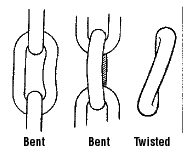Materials Handling – Chain Slings Fact Sheet
WHO SHOULD INSPECT CHAIN SLINGS?
A competent person (sometimes referred to as a designated person) is responsible for all sling inspections.
When should you inspect chain slings?
All slings (new, altered, modified, or repaired) should be inspected by a competent person before they are used in the workplace to make sure they are built to specifications, not damaged, and will be appropriate for the work being performed. For record keeping purposes it is useful if each chain has a metal tag with an identification number and load limit information. Information about the chain length and other characteristics and an inspection schedule should be recorded in a log book.
A competent person must also inspect chain slings periodically, and at least once a year. Inspection frequency is based on how often the sling is used, the types of lifts being performed, the conditions in which the sling is being used, and past experience with service life of similar slings and usage. If the sling is used in more severe conditions, then the inspection should be performed every 3 months. Inspections must be recorded.
In addition to the inspections by a competent person, the user should inspect chain slings and accessories before each use and before placing into storage. Check for visible faults in links and hooks and distortion of fittings.
How should chain slings be checked during inspection?
- Clean sling before inspection.
- Check identification tag
- Hang the chain up or stretch the chain out on a level floor in a well-lighted area. Remove all twists. Measure the sling length. Discard if a sling has been stretched.
- Make a link-by-link inspection and discard if:
a) Wear exceeds 15% of a link diameter.

b) Cut, nicked, cracked, gouged, burned, weld splattered, or corrosion pitted.

c) Deformed, twisted or bent chain links or components.

d) Stretched. Links tend to close up and get longer.

- Check master link, load pins and hooks for any of the above faults. Hooks should be removed from service if they have been opened more than 15% of the normal throat opening, measured at the narrowest point, or twisted more than 10° from the plane of the unbent hook.
- Manufacturers’ reference charts show sling and hitch capacities. Record manufacturer, type, load limit and inspection dates.
Source: © Copyright 1997-2021 CCOHS